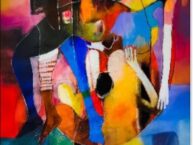 Romi Jain is a published poet, writer, novelist, and Vice President of the Indian Journal of Asian Affairs. Her published creative works include The Storm Within (2008; 2011), Poetry! You Resurrect Me (2011) and Voices of Rocks in the Dusk (2012), apart from the numerous poems that have appeared or are forthcoming in international anthologies and literary journals.
Romi Jain is a published poet, writer, novelist, and Vice President of the Indian Journal of Asian Affairs. Her published creative works include The Storm Within (2008; 2011), Poetry! You Resurrect Me (2011) and Voices of Rocks in the Dusk (2012), apart from the numerous poems that have appeared or are forthcoming in international anthologies and literary journals.
Four Poems by Romi Jain
Old Age
Some of us think old age is not for us
and when it comes
it is hard to believe.
And some people are gentle enough
to remind us
‘one is young by spirit’
which becomes fuel for our drive to bold experiments
with dresses and pursuits.
But let’s refrain from guessing the opinion of opposite sex,
and not be concerned either,
since some in youth doubt their youth,
some claim the crown of cherry blossoms in autumn,
while some are smart enough to summarily reject
the words of the young, claiming in Asian fashion
authority over wisdom.
And there are those who don’t proclaim superiority
of any phase. They’re like tourists,
capable of appreciating each landmark, even a street,
trusting the steerer:
passing through playgrounds, wedding processions,
difficult terrains, zigzag routes from hills to valleys,
from vales to hillocks, from nurseries
to the path of denuded trees,
and never minding a final seat in a cemetery.
Treating Roughly
Some treat people as if they are windows
and some vindicate their wills
by smashing an unwilling door.
How in professional lives this attitude manifests,
when her ‘no’ is looked at with askance
by the dreamers of a beautiful pillow.
Love as a Maxim
Some treat love as a geometrical maxim
that withholds acknowledgment
of its growth into a bloom,
without consummation.
Intact hair is frowned upon
as the husk untouched by a storm;
dry lips as a raw cherry,
which awaits carnal warmth.
Just as a hairstyle
would be encouraged to be copied
from a fashion book
and diversion would be antithetical
to a perfect look,
coquetry, a cart, follows as its application;
the kiss, a horse, as a compass.
The Three Shapes of a Poem
The shape of a poem is not in its visual form,
determined by a meter,
a stanza, a rhyme, a comma, a period
What takes birth in the mind
appears with a pre-ordained shape,
like a living body whose transformations
occur within a pre-defined frame.
Verses appear in three different shapes.
The flow that blinds us to see the fringes
that a lapidary would rather cut off:
just as someone awed by the Niagara Falls
wouldn’t notice the logic
of the Bridal Veil Falls or Canadian Horseshoe Falls,
named after their appearances.
The steel framework
in which verses are arranged like squares in a box,
when a packager considers inserting a triangle
in a triangular slot. It is like a bird with clipped wings,
and which walks a step or two.
The third is a combination of the other two,
and yet transcends:
a fountain
that flows in a mapped direction from the air to the base,
whose beauty in a sculpture manifests– as God,
the dolphins, the Barberini bees do for the Triton Fountain
and which promises quenching the thirst:
this is the verse that can claim
a perfect shape
as a paraphernalia to its beauty and utility.


